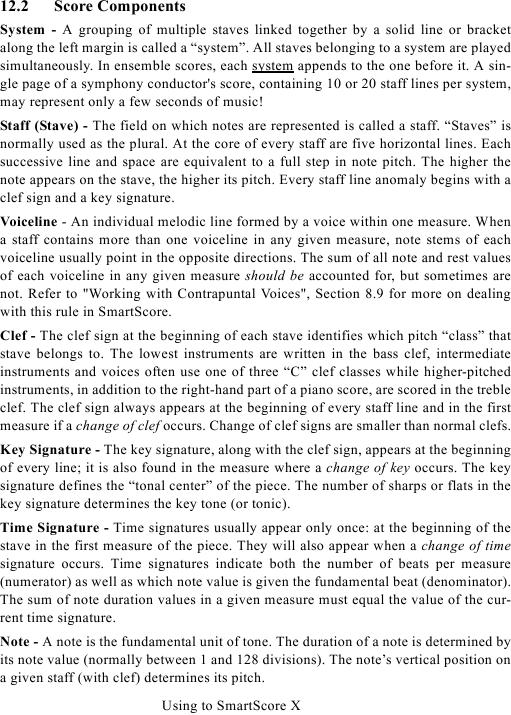12.2
Score Components
System - A grouping of multiple staves linked together by a solid line or bracket
along the left margin is called a "system". All staves belonging to a system are played
simultaneously. In ensemble scores, each system appends to the one before it. A sin-
gle page of a symphony conductor's score, containing 10 or 20 staff lines per system,
may represent only a few seconds of music!
Staff (Stave) - The field on which notes are represented is called a staff. "Staves" is
normally used as the plural. At the core of every staff are five horizontal lines. Each
successive line and space are equivalent to a full step in note pitch. The higher the
note appears on the stave, the higher its pitch. Every staff line anomaly begins with a
clef sign and a key signature.
Voiceline - An individual melodic line formed by a voice within one measure. When
a staff contains more than one voiceline in any given measure, note stems of each
voiceline usually point in the opposite directions. The sum of all note and rest values
of each voiceline in any given measure should be accounted for, but sometimes are
with this rule in SmartScore.
Clef - The clef sign at the beginning of each stave identifies which pitch "class" that
stave belongs to. The lowest instruments are written in the bass clef, intermediate
instruments and voices often use one of three "C" clef classes while higher-pitched
instruments, in addition to the right-hand part of a piano score, are scored in the treble
clef. The clef sign always appears at the beginning of every staff line and in the first
measure if a change of clef occurs. Change of clef signs are smaller than normal clefs.
Key Signature - The key signature, along with the clef sign, appears at the beginning
of every line; it is also found in the measure where a change of key occurs. The key
signature defines the "tonal center" of the piece. The number of sharps or flats in the
key signature determines the key tone (or tonic).
Time Signature - Time signatures usually appear only once: at the beginning of the
stave in the first measure of the piece. They will also appear when a change of time
signature occurs. Time signatures indicate both the number of beats per measure
(numerator) as well as which note value is given the fundamental beat (denominator).
The sum of note duration values in a given measure must equal the value of the cur-
rent time signature.
Note - A note is the fundamental unit of tone. The duration of a note is determined by
its note value (normally between 1 and 128 divisions). The note's vertical position on
a given staff (with clef) determines its pitch.
Using to SmartScore X

